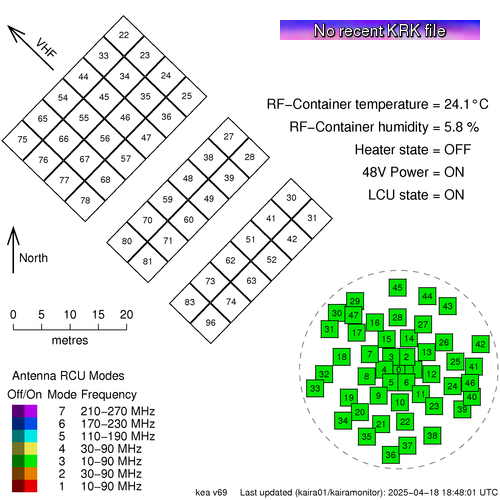I myself have never used R before; my native language is actually C, with PostScript, Python, FORTRAN as some of the others that I know. I've been aware of R because my colleagues use it, but other than that I've not had a chance to use it. I keep meaning to write something, but those opportunities rarely come up and, when they do, it is usually faster to hack something out in a language I know.
But a couple of days ago an good opportunity presented itself, so here's my first real programme beyond the "Hello world!".
Lassi has asked for some KAIRA data, in particular some beamlet statistics data. These are the data generated by any LOFAR single station. Not only did he want the data, but also a way to plot it... using R (which is what he uses). Fair enough. So here's my attempt:
R-code to plot a single beamlet from a LOFAR beamlet statistics (BST) file.
# Set the name of the file that we wish to read
filename = "20131220_150320_bst_00X.dat"
# Set the beamlet number we wish to plot
beamlet = 243
# Create a connection to this file
file = file(filename,"rb")
# Typical maximum file size (244 beamlets x 86400 seconds/day)
maxsize = 244 * 86400
# Read the entire file as a raw data stream (up to maxsize)
raw = readBin(file,double(),size=8,n=maxsize,endian="little")
# Re-shape the data into matrix w/ 244 columns (beamlets)
data = matrix(raw,ncol=244,byrow=TRUE)
# Convert the data into a dB scale
data_db = 10.0*log10(data)
# Create an array of sample numbers for the X-axis
sample_num = array(1:dim(data_db)[1])
# Plot the data (we need "beamlet+1"; R counts from 1, not 0)
plot(sample_num,data_db[,beamlet+1],
xlab="Samples since file start time",
ylab=expression("ADUs 10log"[10]),
main=paste("KAIRA ",filename," Beamlet=",beamlet) )
The plot looks like this:
I also plotted the same thing with KPB (KAIRA Plot Beamlet-statistcs). KPB is the python software that we normally use for plotting things.
For those curious, the command line settings for this were:
% kpb --db -y 243 20131220_150320_bst_00X.dat -g trace \
-t "KAIRA %n bl=243" -o kpb_example.png
Of course I will continue to use Python and C code, as that is what I do. However, hopefully the above code fragment will help anyone either learning R or getting started with LOFAR single-station data.
Bear in mind that I am a novice though! So, if you're an R-expert and have suggestions on how I could improve that code, or make it more R-esque, do let us know in the comments below!
Links
- http://www.r-project.org/ -- R programming home page
- http://en.wikipedia.org/wiki/R_%28programming_language%29 -- Wikipedia








